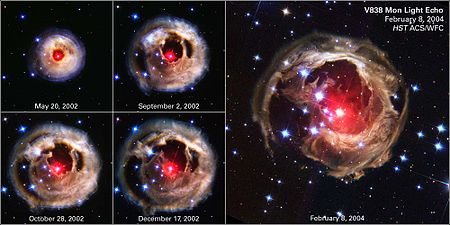V838 monocerotis
|
Stern V838 Monocerotis |
|||
|---|---|---|---|

|
|||
| V838 Monocerotis on December 17, 2002 | |||
| AladinLite | |||
|
Observation dates equinox : J2000.0 , epoch : J2000.0 |
|||
| Constellation | unicorn | ||
| Right ascension | 7 h 04 m 4.85 s | ||
| declination | -3 ° 50 ′ 51.1 ″ | ||
| Apparent brightness | 15.74 mag | ||
| Typing | |||
| Spectral class | M. | ||
| Astrometry | |||
| distance | approx. 20,000 ly approx. 6,100 pc |
||
| Physical Properties | |||
|
Other names and catalog entries |
|||
|
|||
V838 Monocerotis ( V838 Mon for short ) is a luminous red nova in the constellation Unicorn (Monoceros). It is about 6.1 kilo parsecs (20,000 light years ) from Earth and has an apparent magnitude of 15.74 mag.
The designation V838 Monocerotis means “838. variable star of the Monoceros (unicorn) ”.
outbreak
At the beginning of 2002 a strong outburst of brightness was observed, which can presumably be explained as a merger burst during the merging of a binary star system . The outbreak was discovered by NJ Brown on January 6, 2002. A comparison with archive images revealed that it must have taken place around January 1st, 2002, after J. Bedient's recordings. The first outbreak was relatively unspectacular and comparable to the behavior of a star of the Nova type .
The second outbreak was discovered on February 2, 2002 in Innsbruck and independently a few hours later in the Czech Republic and Poland . Its light echo was discovered on February 17th at the US Naval Observatory and, due to its rapid expansion, led to the misjudgment that the object is only about 700 parsecs away.
This second eruption and the very unusual behavior that followed led to observation by the Hubble Space Telescope . The images went around the world and later led to the false assumption that it was a discovery by the Hubble.
As a result of the eruption, the star became ten thousand times brighter in a few days than before and therefore brighter than all other stars in the Milky Way .
Today it is known that the star is at a distance of about (6100 ± 800) parsecs. Two independent measurement methods were used for this.
Hubble has taken about 120 recordings since February 9, 2002. The last one so far dates from September 28, 2009 and was recorded with the long-wave filter F814 in the beginning of the infrared light spectrum. Astronomers expected light reflections from this eruption to be visible until 2010.
After the supernova 1987A , this is the second event in which the light echo generated by material in the immediate vicinity of the star could be recorded in a spectacular way . Light echoes have long been a tool used intensively in the professional world for studying variable stars and have been observed very often.
Radio observations of the CO lines enabled the origin of the matter responsible for the light echo to be found. It is a molecular cloud surrounding the V838 Mon group . In addition to the namesake, at least three early stars with the spectral classes B3 to B6 as well as the B3 companion of V838 Monocerotis belong to the V838 Mon group . Since the molecular cloud has not yet dissolved despite the intense ultraviolet radiation of the early stars, the maximum age of the cloud, and thus of V838 Mon, can be estimated to be less than 25 million years.
V838 Mon, in contrast to novae or supernovae, hardly lost any matter at high speed during this eruption , but instead expanded enormously and transformed into a cool supergiant with a diameter of over 1,560 million kilometers.
From 2004 to 2006, the observations showed signs of a blue companion star. This is what the ever expanding envelope seems to have reached around December 2005. Finally, in October 2006, the shell reached dimensions in which the companion was completely swallowed.
swell
- ↑ International Astronomical Union Circular No. 7785
- ↑ International Astronomical Union Circular No. 7790
- ↑ International Astronomical Union Circular No. 7816
- ↑ International Astronomical Union Circular No. 7859
- ↑ bibcode : 2007AJ .... 133..387A , bibcode : 2008AJ .... 135..605S
- ↑ bibcode : 2009A & A ... 495..371B
- ↑ T. Kamiński, R. Tylenda, S. Deguchi: A molecular cloud within the light echo of V838 Monocerotis . In: Astronomy & Astrophysics . tape 529 , 2011, pp. A48 , doi : 10.1051 / 0004-6361 / 201016229 .
- ↑ bibcode : 2005A & A ... 434.1107M
- ↑ http://www.astronomerstelegram.org/?read=803
- ↑ http://www.astronomerstelegram.org/?read=966
